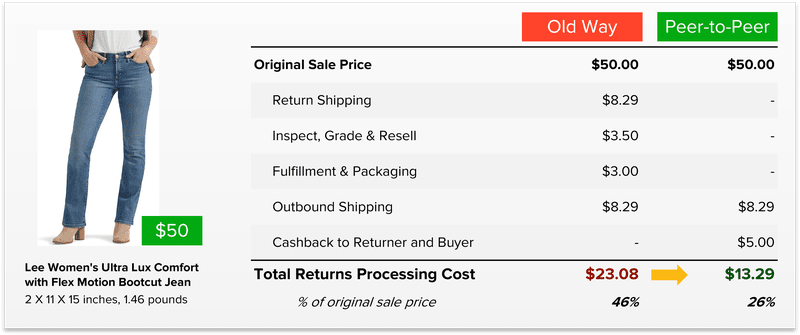How to Source Products Domestically in 2025 (and Actually Stay Profitable)

Last updated on April 14, 2025

In this article
 9 minutes
9 minutes
- Rethinking the Game: Why Domestic Sourcing Makes Sense in 2025
- Step-by-Step: How to Start Sourcing Domestically
- Can You Stay Profitable While Sourcing Locally? Absolutely.
- The Pros and Cons of Reshoring
- Where to Find Domestic Suppliers: Your 2025 Resource Guide
- Real-World Examples of Domestic Sourcing in Action
- Final Thoughts: Reshoring as a Competitive Edge
- Frequently Asked Questions (FAQs)
It’s 2025, and ecommerce is going through one of its biggest shakeups in years. Thanks to the sweeping Liberation Day tariffs introduced by the Trump administration, the familiar playbook of sourcing products cheaply from overseas, especially from China and other Southeast Asian countries, is being rewritten in real-time. Merchants who’ve relied on low-cost international supply chains are now facing rising costs, shipping delays due to trade tensions, and a whole lot of uncertainty.
Understandably, many ecommerce sellers are nervous. Domestic sourcing sounds expensive, slow, or just plain confusing. But here’s the truth: sourcing products closer to home doesn’t just help you sidestep the tariff problem, it can actually make your business leaner, faster, and more resilient.
In this guide, we’ll walk through how to navigate the shift, explore the real pros and cons of reshoring, and share resources to help you make the switch without wrecking your margins.
Rethinking the Game: Why Domestic Sourcing Makes Sense in 2025
The tariffs have changed the math. What used to be a no-brainer, ordering large quantities from overseas suppliers to save on unit costs, has become a gamble. Costs are up, shipping times are unpredictable, and compliance headaches are stacking up.
On the flip side, domestic sourcing offers a new kind of advantage. Local suppliers mean faster restocks and lower minimum order quantities. There’s no waiting four to six weeks for a container to clear customs or worrying about shutdowns during Lunar New Year. You’re also aligning your brand with a growing consumer demand for transparency, sustainability, and “Made in USA” pride.
And while many assume domestic production is always more expensive, that’s not a given. When you factor in things like lower inventory risk, faster delivery, and fewer returns due to quality issues, the numbers often work out better than expected.
Step-by-Step: How to Start Sourcing Domestically
The first step in making the switch is to get clear on what you’re currently sourcing, and why. Take a hard look at your catalog. Which products are most affected by tariffs or shipping volatility? Which ones are top sellers and worth investing in locally? Which SKUs can be streamlined or combined to simplify sourcing?
Once you’ve identified the products to shift, it’s time to look for suppliers. The good news? There are more domestic sourcing platforms than ever before. You can start with well-known directories/services like Thomasnet, SourcingHub, or Wonnda. These sites let you filter for U.S.-based suppliers and often include valuable info on certifications, production capacity, and turnaround times.
You can also explore directories like SaleHoo, Wholesale Central, and Worldwide Brands. These marketplaces are designed specifically for ecommerce merchants and include both wholesalers and dropshippers. If you’re looking for more artisan or niche options, platforms like Faire and Handshake connect you with independent U.S. makers who often have more flexible terms and faster lead times.
Before you commit to any supplier, though, take your time vetting them. Ask about minimum order quantities, fulfillment capabilities, and their experience working with ecommerce brands. If possible, request product samples or a virtual walkthrough of their facilities. Some merchants even find it worthwhile to visit domestic suppliers in person. Relationships matter when you’re betting on supply chain reliability.
And don’t be afraid to negotiate. Many U.S. suppliers are eager for new business and open to collaboration. If you’re upfront about your volumes, timelines, and growth goals, you may be able to lock in favorable pricing or test runs.
Can You Stay Profitable While Sourcing Locally? Absolutely.
Profitability doesn’t disappear with reshoring, it just looks a little different. Faster turnaround times mean you can hold less inventory and restock more responsively. That reduces your cash flow risk and lowers the chance of over-ordering and sitting on dead stock.
It’s also a great time to simplify your product line. Instead of offering dozens of SKUs, focus on your best sellers. Consider bundling items to increase perceived value without raising your costs. And look at how you can tweak your product design to use more accessible, interchangeable, or regionally available materials.
Smart demand forecasting tools can help here, too. With shorter lead times, you can react quickly to trends and avoid tying up capital in slow-moving stock. The goal is agility, not just cost-cutting.
The Pros and Cons of Reshoring
It’s not a magic bullet, but for many brands, the trade-offs are worth it, especially when combined with smarter inventory management and focused product strategies.
Where to Find Domestic Suppliers: Your 2025 Resource Guide
Whether you’re looking for mass production, handcrafted goods, or something in between, here are some of the top directories and platforms to explore:
- Thomasnet – The gold standard for U.S. manufacturers, with a wide range of industrial and consumer product suppliers.
- SourcingHub – Curated list of top-tier U.S. factories and manufacturers.
- SaleHoo – Great for ecommerce merchants, includes wholesalers and dropshippers.
- Wholesale Central – Free access to thousands of U.S.-based wholesalers.
- Worldwide Brands – Lifetime access to pre-vetted domestic suppliers.
- TopTenWholesale – Includes filters for location and product categories.
- Faire & Handshake – Connect with U.S. artisan brands and indie product makers.
- Inventory Source – Helpful for ecommerce Sellers looking to automate supplier integration and fulfillment.
- Wonnda – Connects you with local manufacturers and private label producers.
Real-World Examples of Domestic Sourcing in Action
Brands of all sizes are making the shift. Allbirds has localized parts of its production for faster distribution. Beardbrand uses small-scale U.S. manufacturers to stay agile and respond to trends quickly. Some others include:
1. American Giant
This apparel company built its entire brand around “Made in the USA,” focusing on domestic manufacturing to ensure quality control and a transparent supply chain. By doing so, they’ve cultivated a loyal customer base that values ethical production and craftsmanship.
2. GRACE Eleyae
This haircare accessories brand moved production to the U.S. to shorten shipping timelines and respond to customer demand more quickly. They’ve seen improved inventory agility and enhanced brand trust from their mostly North American customer base.
3. Parachute Home
While originally sourcing globally, Parachute shifted to U.S.-based production for several core product lines, including mattresses and furniture. This move improved delivery speed and allowed for more direct oversight of product quality and safety.
4. Bombas
Although they started with international sourcing, Bombas has introduced more domestic partnerships to support scaling while maintaining their high product standards. U.S. manufacturing helps them meet seasonal spikes and support social impact initiatives more closely tied to their community-driven brand.
These companies aren’t just reacting, they started reshoring efforts well before the actual Liberation Day tariff announcements. They’re turning sourcing into a competitive advantage. With shorter lead times, more predictable inventory, and marketing narratives customers actually care about, they’re staying ahead of the curve.
Final Thoughts: Reshoring as a Competitive Edge
Shifting to domestic sourcing might feel like a big leap, but in reality, it’s a smart evolution. The old way of doing things, buying cheap, buying big, and hoping for smooth sailing, is no longer reliable. In a world of volatile tariffs and trade policy, and with unpredictable shipping lanes, local sourcing offers something increasingly rare: control.
By acting now, ecommerce merchants can build more resilient businesses, forge stronger supplier relationships, and tap into a growing consumer preference for local and transparent brands. It’s not just about surviving 2025, it’s about thriving in it.
Need help figuring out your first move? Start small. Pick one SKU. Test a local partner. And take it from there. The new supply chain is closer than you think.
Frequently Asked Questions (FAQs)
Is domestic sourcing really more profitable than importing from overseas?
Domestic sourcing can be more profitable when you account for total costs, not just unit price. Tariffs, shipping delays, customs fees, and long lead times all eat into profit margins. By sourcing locally, you can reduce inventory risk, increase speed to market, and spend less capital on bulk imports stuck at sea. That agility can translate into better cash flow and faster growth.
Where can I find trustworthy U.S.-based suppliers or manufacturers?
Start with reputable directories like Thomasnet, SourcingHub.io, and SaleHoo. Platforms like Faire and Handshake offer curated U.S. wholesaler access, and communities like Maker’s Row or Indie Source help connect you with small-batch U.S. manufacturers. You can also explore drop shipping through Inventory Source or Wholesale Central, which emphasize verified U.S. suppliers.
Isn’t reshoring more expensive?
Upfront, it can be. But consider the full picture. You’ll likely save on freight, customs, port fees, and the cost of excess inventory sitting in transit. Domestic suppliers also allow for smaller, more frequent orders, which can be better aligned with real demand, storage costs, etc. Many businesses actually find that reshoring helps them become leaner, more responsive, and ultimately more profitable over time.
What are some quick wins for ecommerce sellers starting to reshore their sourcing?
Start by auditing your current product catalog. Identify high-margin items or fast movers that would benefit from shorter lead times. Look for SKUs that are simple to manufacture and easy to ship. Also, consider transitioning one product line at a time to test domestic sourcing and refine your approach without disrupting your entire business.
How do I make “Made in USA” part of my brand story?
Highlight the benefits customers care about: quality, faster shipping, and ethical labor practices. Share behind-the-scenes looks at your manufacturing partners. Let customers know they’re supporting local jobs and sustainable practices. U.S.-based sourcing can be a powerful differentiator if you weave it authentically into your marketing and packaging.

Up to 64% Lower Returns Processing Cost


